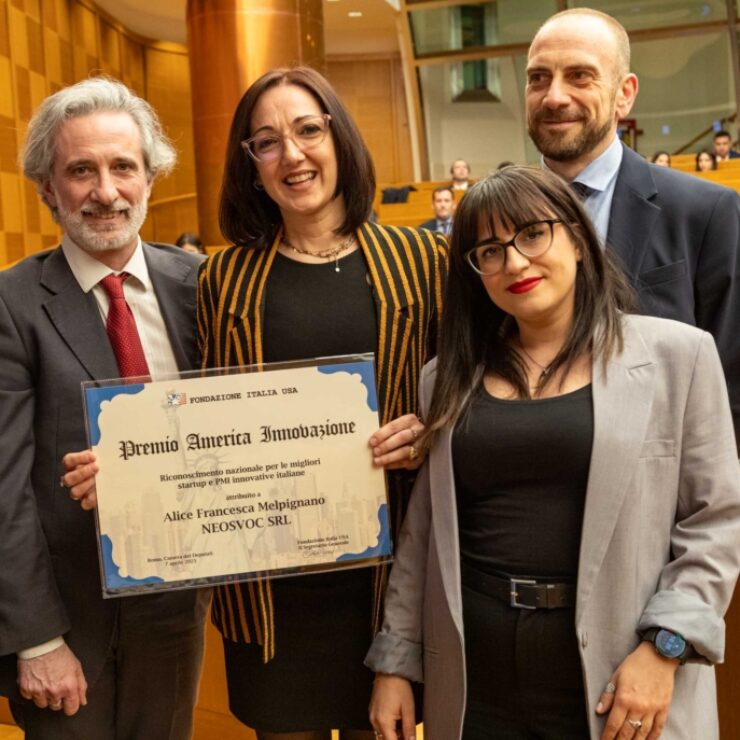At the Web Marketing Festival 2022 we engaged attendees in the ‘Aware or Consumerist?’ research aimed at understanding the level of inclination towards environmental sustainability among a highly selected group: marketing professionals present at the Rimini event. To achieve this, we utilized the Green Potential Detection Model. Over 200 people responded, and here we share what emerged.
This is the second article. The first, focused on the overall results, can be found here.
Part of the questionnaire administered to our audience sample at the Web Marketing Festival focused on detecting psychographic traits.
The goal was to move beyond the usual sociographic segmentation of individuals, allowing us to gather data on dispositional and emotional traits of each person, which deeply influence their choices, lifestyles, and preferences.
What are psychographic traits?
People potentially environmentally aware
But let’s turn to our sample of marketers (remember that the sample consists of people working in the field of marketing and communication, as we explained here) and the psychographic traits that characterize them.
In general, this is a sample that exhibits traits strongly correlated with sustainable behavior.
The first 4 traits that describe them, in fact, are characteristic of individuals who are attentive to their direct environmental impact. They reach a presence value in respondents’ personality profiles exceeding 60%, and these are: Openness (69.4%); Conscientiousness (69.1%); Empathy (66.2%); Universalism (62.8%).
Let’s delve into what these traits indicate in detail.
Openness
Creativity, imagination, originality, intellectual and artistic curiosity: these are the elements that characterize the trait of openness. The pronounced interest in beauty and the typical welcoming approach to new ideas and proposals that characterize individuals with high openness translates into behaviors that also have positive consequences for environmental conservation and participation in conservation projects.
Conscientiousness
Conscientiousness involves self-discipline, perfectionism, and a strong sense of duty: traits that reflect environmental commitment. The conscientious individual is concerned about the future and the consequences of their actions, consistently striving to adhere to social norms oriented towards sustainability.
Empathy
Empathy is the ability to empathize with others, to give shape and meaning to external stimuli. It is an attitude that leads to including Nature within oneself, whereby individuals with this trait generally have a greater sense of responsibility and exhibit positive behavior towards the environment.
Universalism
Universalism is the commitment to promoting welfare and prosperity beyond one’s individual sphere, extending it to all of humanity. The altruistic person, who is also highly empathetic, lives by strong values and often translates their daily actions into significant attention towards sustainable consumption and environmental conservation.
While the traits described so far all show a positive correlation with the propensity to engage in sustainable behaviors, starting from the fifth position, traits appear that are counterproductive to ethical consumption tendencies. Chief among these is Self-Assertion: with a trait presence value of 59.2% in the sample, this aspect of personality predicts a certain individualistic drive among individuals, which does not align well with green initiatives. Moreover, Self-Assertion appears more prominently in the psychographic profile of respondents compared to Warmth (58.2%), the trait most closely associated with environmental awareness.
Contributing negatively to sustainability propensity are also significant percentages related to the trait of Extraversion, present in over half of the surveyed sample. Not to be confused with Warmth, Extraversion brings elements of openness more closely tied to individual achievement and personal goals rather than collective endeavors. For these reasons, the presence of this trait could limit the inclination towards adopting behaviors that are closely aligned with community objectives.
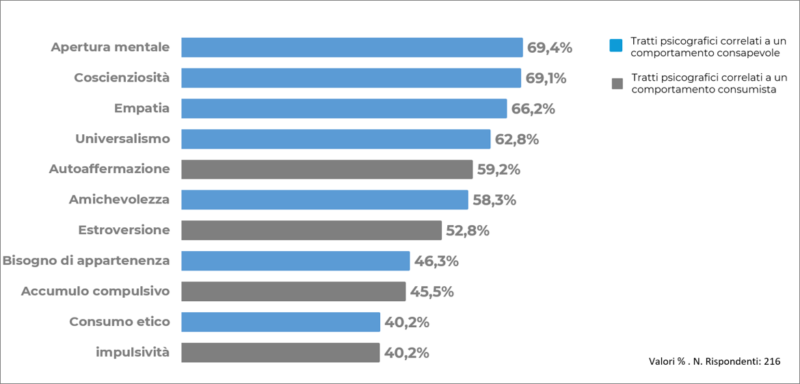
From traits to behaviors
So, how does this inclination towards a sustainable life vision translate into actually sustainable behaviors?
In other words, if there are categories of people naturally inclined towards sustainable behavior, how much do these same individuals actually implement such actions in real life?
We can answer this by analyzing self-reported behaviors, grouped into three major categories: propensity for energy saving, sustainable lifestyle, and water saving propensity.
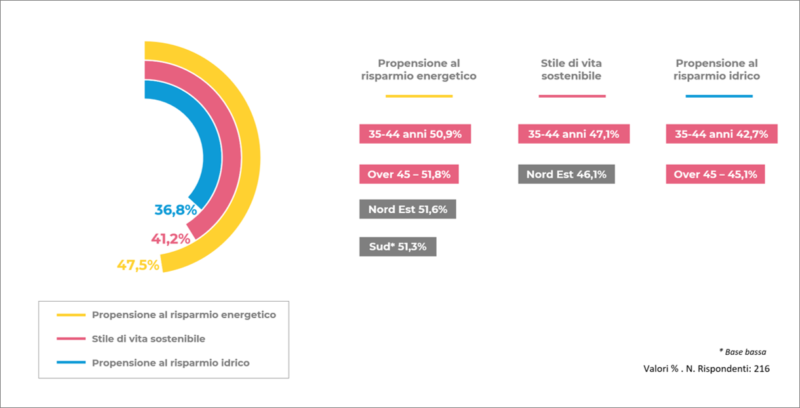
Energy saving propensity
The first index is the synthetic and weighted result of a series of behaviors that demonstrate (or not) attention and sensitivity towards avoiding the waste of energy resources, such as attention to renewable energies, timing of appliance usage, or thoughtful use of air conditioning.
On a scale from 1 to 10, overall, the level reached by our sample on this index is 4.75, indicating that there is still work to be done on individual choices to approach at least a passing score.
Certainly, there are differences on this topic among the various participant groups. The age groups over 35 achieve higher scores, particularly the 35-44 age group with a score of 5.1 and the over 45 age group with a score of 5.2. Geographically, there is greater attention noted in the Northeast, with a score of 5.2.
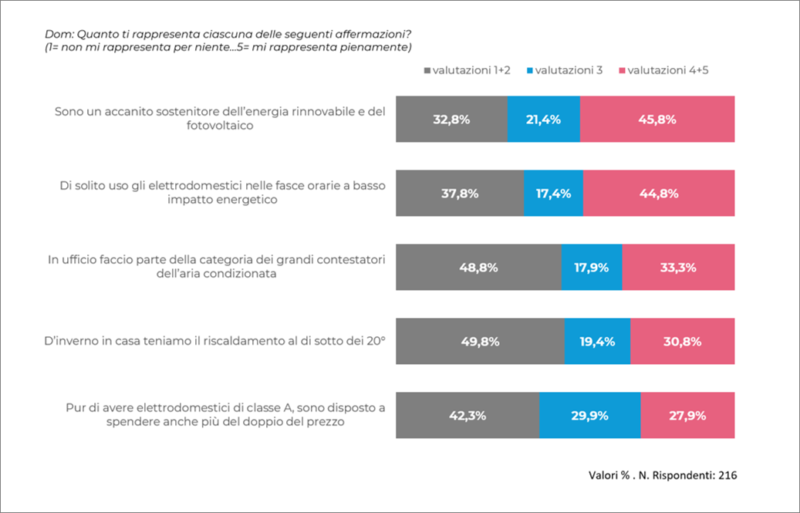
Sustainable lifestyle
This synthetic index encapsulates all behaviors that indicate varying levels of sensitivity towards the well-being of our planet. Even on this aspect, a satisfactory result is not achieved, with the score stopping at 4.1.
But why is this? The hectic lifestyle, lack of attention to the origin and seasonality of products leads to unsustainable behavior, albeit unintentionally. Specificities are noted here as well: the Northeast confirms a more virtuous approach with a score of 4.6, and the 35-44 age group scores 4.7.
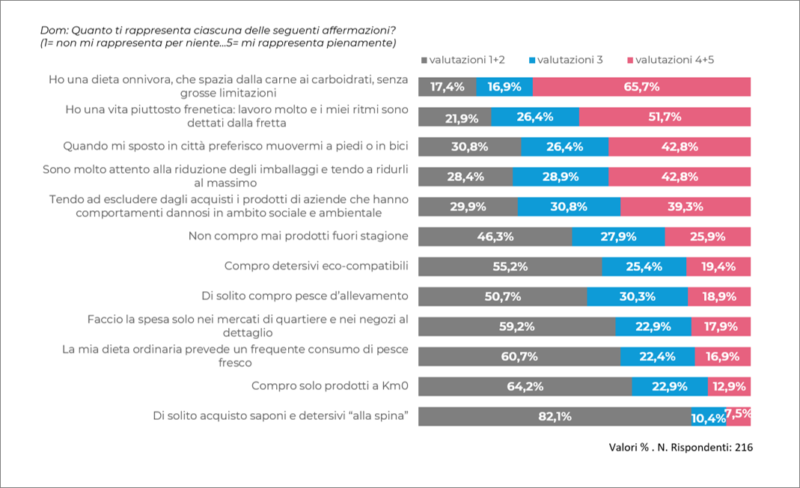
Water saving propensity
Unfortunately, even for the last index, the results are not encouraging.
The level reached by this indicator is the lowest overall: the score is 3.7, well below sufficiency.
A small glimmer of hope, even in this case, comes from age groups over 35 years. Indeed, we see that the 35-44 age group reaches 4.8 and those over 45 reach 4.5. These are positive results, but not truly encouraging: attitudes that are definitely not beneficial to scarce water resources are still too deeply rooted. For example, 33% of the sample still washes dishes by hand, or drinks bottled water rather than tap water (a behavior reported by 34% of the sample).
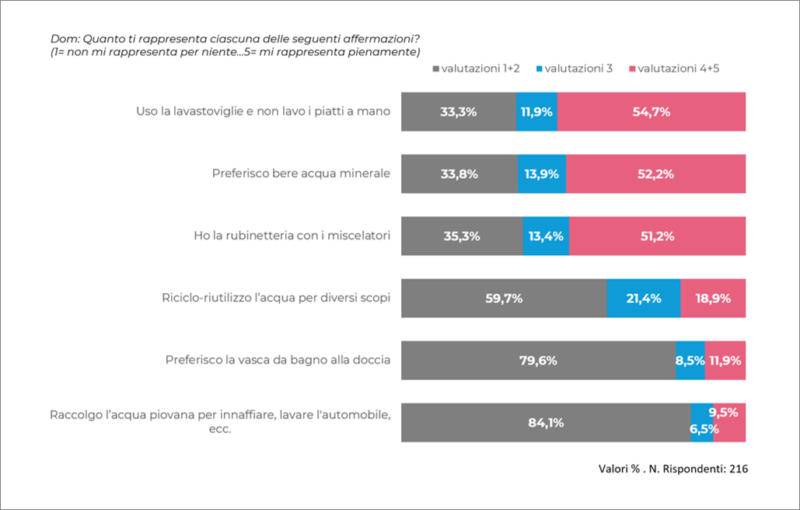
Difference between psychographic traits and behaviors
Why is there a difference between psychographic traits and behaviors?
As we have seen, psychographic traits reveal individuals’ natural disposition to act in certain ways in specific situations. These traits provide insights into people’s subjective and individual characteristics, such as emotions, values, and attitudes, which determine the motivations behind their behaviors.
Behaviors, on the other hand, are the result of a subsequent processing of these dispositional traits, occurring at a cognitive level. Before engaging in a behavior, individuals are influenced not only by their inner selves but also by everything external that interacts with them. Thus, a range of factors come into play, combining to influence intentions, which then determine the behavior.
As social psychology teaches us, our actions are not solely the result of our inner selves but are also influenced by the people around us, the groups to which we belong, personal relationships, the teachings from primary and secondary socialization, and the pressures we experience from others.
We can say that the natural predisposition to generate a certain behavior is not enough on its own; much also depends on the environment and society in which we live. If society does not create conditions that allow us to actually transform those natural dispositions into behaviors, the consequence is that we must constantly adapt our behaviors to the context we live in and the people we interact with. This adaptation is what Festinger* refers to as “cognitive dissonance reduction”: when an individual is torn between two cognitive styles (opposing attitudes or an attitude and a behavior), an inner discomfort arises that the person seeks to reduce, in order to maintain a balanced and coherent relationship with others and themselves.
By examining these analyses in relation to the age of the participants, we discovered a finding that intrigued us. This will be explored in the next chapter.
*Leon Festinger, A Theory of Cognitive Dissonance. California, Stanford University Press 1957.

